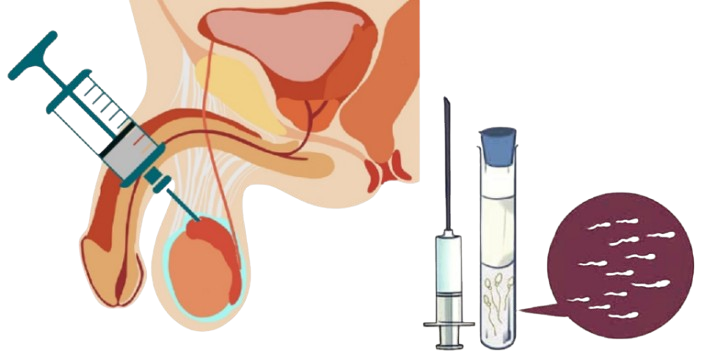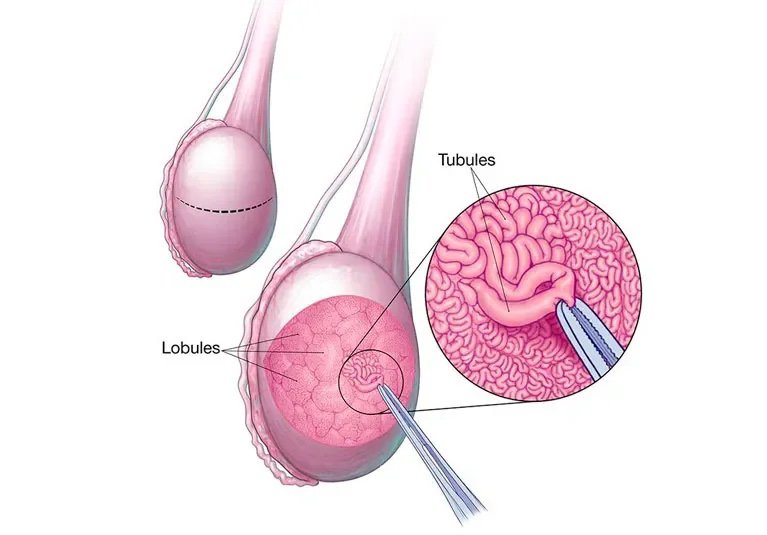Testicular Biopsy
via Aspiration
What is Testicular Sperm Aspiration (TESA)?
Testicular Sperm Aspiration (TESA) is a medical procedure performed to extract sperm directly from the testicle for use in in-vitro fertilization (IVF). This technique is commonly utilized when sperm cannot reach the ejaculate due to a blockage or obstruction in the reproductive tract.
TESA is considered a minimally invasive procedure compared to testicular sperm extraction (TESE), which involves a surgical incision. In TESA, a thin needle is inserted into one of the testicles to collect sperm, eliminating the need for a surgical cut. Therefore, the procedure is deemed safe and does not cause significant trauma or damage to the testicles.
TESA is the preferred method for patients with obstructive azoospermia. But what exactly is this technique, when is it used, and how is it performed?

What is Obstructive Azoospermia?
Obstructive azoospermia is a condition characterized by the absence of sperm in the semen despite normal sperm production in the testicles. This occurs due to a blockage in the reproductive ducts, preventing sperm from entering the ejaculate.
This condition is commonly observed in men who have undergone vasectomy (surgical severing of the vas deferens, the tubes that carry sperm from the testicles). It may also result from other congenital or acquired abnormalities. TESA is the preferred technique for sperm retrieval in such cases.

How is Fertilization Achieved?
TESA is often performed in conjunction with in-vitro fertilization (IVF). In this process, sperm is retrieved from the male partner, while eggs are harvested from the female partner after she undergoes a hormonal stimulation program to ensure the availability of multiple mature eggs.
The collected sperm and eggs are combined in a highly controlled laboratory environment. After a few days, the resulting embryos are transferred into the uterus.
Typically, TESA is performed on the same day as egg retrieval for immediate fertilization. However, in cases where the male partner cannot be present on the day of egg retrieval, the extracted sperm can be frozen and stored for future use.
Frequently Asked Questions FAQ
How is TESA Performed?
TESA can be performed in a fertility and reproductive health center under local anesthesia. The procedure involves numbing the testicles and surrounding skin, followed by securing the testicle between the thumb and forefinger. A thin needle is then inserted through the scrotal skin into the testicular tissue to extract multiple samples from different areas.
Once sufficient samples are collected, the needle is removed, and the tissue samples are examined under a microscope to confirm the presence of sperm. Since TESA does not involve surgical incisions, the puncture wound is small, eliminating the need for stitches.
Post-TESA Care
Most patients tolerate the procedure well and recover relatively quickly. Applying cold compresses or ice packs for 24 hours can help reduce swelling in some cases. The dressing can typically be removed the next day, and patients may shower, but hot baths should be avoided for five days.
Some patients may require mild pain relievers such as acetaminophen or ibuprofen for the first three days. Physicians recommend abstaining from sexual activity for four to five days post-procedure.
When Can Patients Resume Normal Activities?
Patients can usually return to their daily activities within 48 hours or once they feel comfortable. However, strenuous activities such as running or heavy lifting should be avoided for at least a week. Any movement causing discomfort should also be minimized.
What Are the Complications of TESA?
Post-procedure complications are rare, as TESA is considered safe and minimally invasive compared to other sperm retrieval techniques. However, like any medical procedure, it carries a small risk of complications, including bleeding, infection at the needle site, or pain, which is the most common side effect.
What Are the Common Symptoms After TESA?
Patients may experience mild symptoms such as discomfort, bruising, or changes in the color of the scrotal skin and base of the penis. These bruises typically resolve within a week. Light swelling or minor pink fluid discharge from the needle site may also occur but usually resolves on its own within a few days. Applying cold compresses and keeping the area clean and dry can help prevent infection.
What Are the Advantages of TESA?
TESA offers several advantages, including minimal tissue trauma and a faster recovery time. The procedure does not require surgical incisions or stitches, nor does it typically necessitate general anesthesia, reducing associated risks. Additionally, multiple sperm samples can be collected from various testicular regions, and the retrieved sperm can be frozen and stored for future use.
